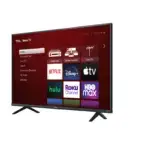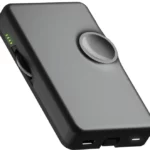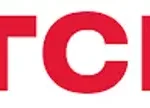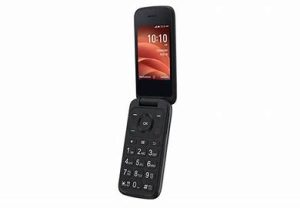

TCL-4056L FLIP Phone User Guide
About your phone
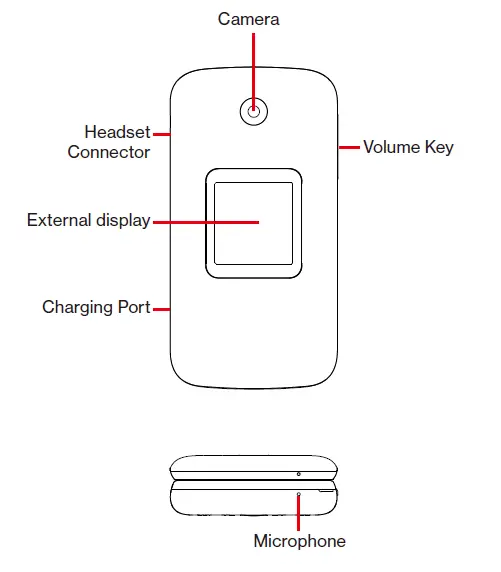 NOTE: Not all features, apps or services may be available with your plan, device operating system and software version. Please contact your wireless service provider for more information. Devices and software are constantly evolving, the screen images and icon you see here are for reference only.
NOTE: Not all features, apps or services may be available with your plan, device operating system and software version. Please contact your wireless service provider for more information. Devices and software are constantly evolving, the screen images and icon you see here are for reference only. 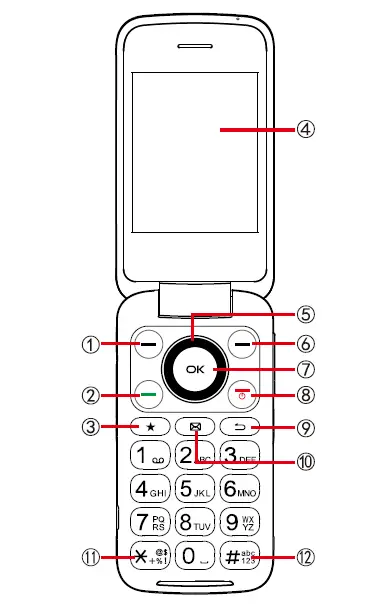 ① Left Soft Key
① Left Soft Key
- Press: to access Notifications
② Call Key
- Press: Make a call
- Press: Enter call log (from Idle screen)
③ Favorite Contacts
- Press: Access Favorite Contacts
④ Internal display ⑤ Navigation Key (up, down, left, right)
- Menu selection moves up, down, right, and left
- Press Left: Access Applications
- Press Up: Access Phone Settings
- Press Right: Access Camera / Video
⑥ Right Soft Key
- Press: Access Contacts
⑦ Center Soft Key
- Confirm an option (press OK key)
- Press: Access app list (from Home screen)
⑧ End/Power Key
- Press: End a call, return to the Idle screen
- Press and hold: to Restart and Power on/off
⑨ Back/Delete Key
- Move backwards through Menus
- Delete entered number or letters
⑩ Messages
- Press: Access Messages
11. Letters symbols
- Press
 then choose a symbol. Press the Center Soft Key
then choose a symbol. Press the Center Soft Key to insert in message or email
to insert in message or email
12. Text input
- Repeat press
 of to change text input method from ABC to Abc, 123 or Predictive text
of to change text input method from ABC to Abc, 123 or Predictive text
Setting up your phone
Your phone already has a NANO SIM card installed. MicroSDTM cards (up to 32GB) may be purchased separately. NOTE: Power off the device before opening the back cover to install a microSD or replace the NANO SIM card. 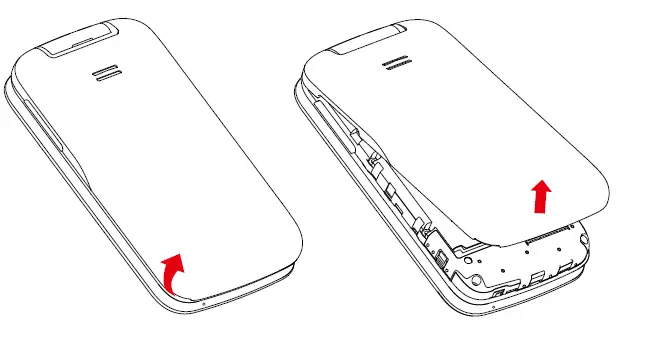 Step 1. With the device facing down, remove the back cover from the bottom left corner. Use your fingernail to carefully lift the cover away from the device body. Step 2. Remove the battery using your fingernail to lift from the top left corner. Step 3. To insert SIM card or microSD card, push the SIM card or microSD card into the card slot with the gold-colored contacts facing down.
Step 1. With the device facing down, remove the back cover from the bottom left corner. Use your fingernail to carefully lift the cover away from the device body. Step 2. Remove the battery using your fingernail to lift from the top left corner. Step 3. To insert SIM card or microSD card, push the SIM card or microSD card into the card slot with the gold-colored contacts facing down. 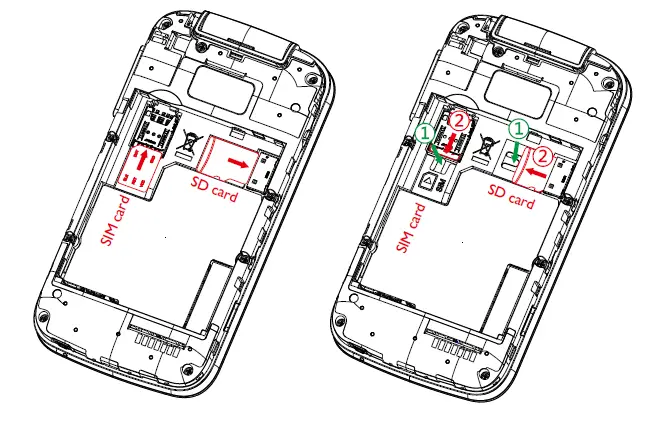 To remove the SIM card or microSD card, press down on the small plastic tab (①), then slide out the card (②). Do not use force or any sharp objects. Step 4. Re-install the battery by aligning the gold contact points of the battery with the gold contact points of the device. It only fits one way. Press down to snap in place. Step 5. Carefully align the back cover with tabs and press into place. It only fits one direction. Step 6. Charge your phone fully before turning it on and starting the set up process. Insert the small end of the charging cable into the charger port on the phone. Insert the other end of the cable into your wall charger and plug it into a wall outlet.
To remove the SIM card or microSD card, press down on the small plastic tab (①), then slide out the card (②). Do not use force or any sharp objects. Step 4. Re-install the battery by aligning the gold contact points of the battery with the gold contact points of the device. It only fits one way. Press down to snap in place. Step 5. Carefully align the back cover with tabs and press into place. It only fits one direction. Step 6. Charge your phone fully before turning it on and starting the set up process. Insert the small end of the charging cable into the charger port on the phone. Insert the other end of the cable into your wall charger and plug it into a wall outlet.  WARNING: Only use the charger and cable supplied with the phone. Using incompatible chargers or tampering with the charging port could damage your phone and void the warranty.
WARNING: Only use the charger and cable supplied with the phone. Using incompatible chargers or tampering with the charging port could damage your phone and void the warranty.
Using your phone
Turn your phone on/off To turn on your phone, press and hold the End/Power Key  . NOTE: The first time you turn on your phone, you may need to activate it. Follow the on screen instructions to set up your phone. To turn off your phone, press and hold the End/Power Key
. NOTE: The first time you turn on your phone, you may need to activate it. Follow the on screen instructions to set up your phone. To turn off your phone, press and hold the End/Power Key  for about 2 seconds. Then press the Navigation Key to select “Power Off”, then press the Center Soft Key to confirm. Locking/Unlocking your screen To keep your phone contents secure and protect your privacy, you can lock the phone screen by creating a password.
for about 2 seconds. Then press the Navigation Key to select “Power Off”, then press the Center Soft Key to confirm. Locking/Unlocking your screen To keep your phone contents secure and protect your privacy, you can lock the phone screen by creating a password.
- From the Home screen, press the Center Soft Key
 , select Settings
, select Settings  , and then press the Navigation Key to select Privacy & Security > Screen lock.
, and then press the Navigation Key to select Privacy & Security > Screen lock. - • Press the Center Soft Key
 and select On to enable screen lock in the Screen lock screen.
and select On to enable screen lock in the Screen lock screen. - Enter the passcode twice and press the Right Soft Key
 to create
to create
Home screen
The Home screen has a convenient shortcut to the KaiOS Store. Using the KaiOS store, you may download many free apps such as Google Assistant, Google Maps and YouTube. Simply press the left side of the Navigation key, and then scroll up and down to select the desired app. 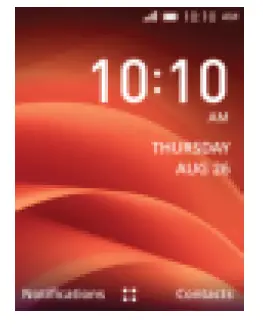
Making a call
- Dial the desired number then press the Call Key
 to place the call.
to place the call. - If you make a mistake, press the Back/Delete Key
 to delete the incorrect digits.
to delete the incorrect digits. - Press the Right Soft Key
 to display more Options. Then press up or down on the Navigation key to select which option you would like to complete
to display more Options. Then press up or down on the Navigation key to select which option you would like to complete
Receiving a call
When you receive a call:
- Press the Left Soft Key
 or the Call Key
or the Call Key  to answer;
to answer; - If the device is closed, you will get a preview of an incoming call on the external screen. You can accept the call by flipping the device open and you can begin talking immediately.
- Press the the Right Soft Key
 or the End/Power Key
or the End/Power Key  to reject;
to reject; - To mute the ringtone volume of an incoming call, press the Volume Up/Down Key .
Calling your voicemail
Press and hold key  to call and listen to your voicemail
to call and listen to your voicemail
General Information
- Visit the TCL website at www.tcl.com for tutorials and answers to frequently asked questions, and to download the User Manual.
- To get support for your phone, visit the TCL website (www.tcl.com), or dial the number listed below: Canada- 1-855-224-4228 United States- 1-855-224-4228
- Update your phone’s software Go to Settings > Device > Device information > System Update to check software updates.
- Reset your phone Go to Settings > Device > Device information > Reset Phone > Reset.
- Add your KaiOS Account Go to Settings > Account > KaiOS account > Create Account.
Safety and Precautions
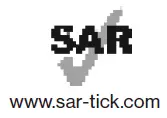 This product meets applicable national SAR limits of 1.6 W/kg. The specific maximum SAR values can be found in the Radio Waves section. When carrying the product or using it while worn on your body, either use an approved accessory such as a holster or otherwise maintain a distance of 15 mm from the body to ensure compliance with RF exposure requirements. Note that the product may be transmitting even if you are not making a phone call.
This product meets applicable national SAR limits of 1.6 W/kg. The specific maximum SAR values can be found in the Radio Waves section. When carrying the product or using it while worn on your body, either use an approved accessory such as a holster or otherwise maintain a distance of 15 mm from the body to ensure compliance with RF exposure requirements. Note that the product may be transmitting even if you are not making a phone call.
PROTECT YOUR HEARING
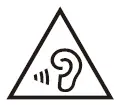 To prevent possible hearing damage, do not listen at high volume levels for long periods. Exercise caution when holding your phone near your ear while the loudspeaker is in use. This phone has been tested and rated for use with hearing aids for some of the wireless technologies that it uses. However, there may be some newer wireless technologies used in this phone that have not been tested yet for use with hearing aids. It is important to try the different features of this phone thoroughly and in different locations, using your hearing aid or cochlear implant, to determine if you hear any interfering noise. Consult your service provider or the manufacturer of this phone for information on hearing aid compatibility. If you have questions about return or exchange policies, consult your service provider or phone retailer.
To prevent possible hearing damage, do not listen at high volume levels for long periods. Exercise caution when holding your phone near your ear while the loudspeaker is in use. This phone has been tested and rated for use with hearing aids for some of the wireless technologies that it uses. However, there may be some newer wireless technologies used in this phone that have not been tested yet for use with hearing aids. It is important to try the different features of this phone thoroughly and in different locations, using your hearing aid or cochlear implant, to determine if you hear any interfering noise. Consult your service provider or the manufacturer of this phone for information on hearing aid compatibility. If you have questions about return or exchange policies, consult your service provider or phone retailer.
Safety and use
We recommend that you read this chapter carefully before using your mobile phone. The manufacturer disclaims any liability for damage, which may result as a consequence of improper use or use contrary to the instructions contained herein. TRAFFIC SAFETY: Given that studies show that using a mobile phone while driving a vehicle constitutes a real risk, even when the hands-free kit is used (car kit, headset…), drivers are requested to refrain from using their mobile phone when the vehicle is not parked. Check the laws and regulations on the use of wireless mobile phones and their accessories in the areas where you drive. Always obey them. The use of these devices may be prohibited or restricted in certain areas. When driving, do not use your mobile phone and headset to listen to music or to the radio. Using a headset can be dangerous and forbidden in some areas. When switched on, your mobile phone emits electromagnetic waves that can interfere with the vehicle’s electronic systems such as ABS anti-lock brakes or airbags. To ensure that there is no problem:
- do not place your mobile phone on top of the dashboard or within an airbag deployment area.
- check with your car dealer or the car manufacturer to make sure that the car’s electronic devices are shielded from mobile phone RF energy.
CONDITIONS OF USE:
- You are advised to switch off the phone from time to time to optimize its performance.
- Switch the phone off before boarding an aircraft.
- Switch the phone off when you are in health care facilities, except in designated areas. As with many other types of equipment now in regular use, mobile telephones can interfere with other electrical or electronic devices, or equipment using radio frequency.
- Switch the phone off when you are near gas or flammable liquids. Strictly obey all signs and instructions posted in a fuel depot, petrol station, or chemical plant, or in any potentially explosive atmosphere.
- When the phone is switched on, it should be kept at least 15 cm from any medical device such as a pacemaker, a hearing aid or insulin pump, etc. In particular when using the phone, you should hold it against the ear on the opposite side to the device, if any.
- To avoid hearing impairment, pick up the call before holding your phone to your ear. Also move the handset away from your ear while using the “hands-free” mode because the amplified volume might cause hearing damage.
- Do not let children use the phone and/or play with the telephone and accessories without supervision.
- If your phone has a removable cover, note that your phone may contain substances that could create an allergic reaction.
- Always handle your phone with care and keep it in a clean and dust-free place.
- Do not allow your phone to be exposed to adverse weather or environmental conditions, such as moisture, humidity, rain, infiltration of liquids, dust, sea air, etc. The manufacturer’s recommended operating temperature range is 0°C (32°F) to 40°C (104°F).
- At over 40°C (104°F), the legibility of the phone’s display may be impaired, though this is temporary and not serious.
- Emergency call numbers may not be reachable on all cellular networks. You should never rely only on your phone for emergency calls.
- Do not dismantle or attempt to repair your mobile phone yourself.
- Do not drop, throw or bend your mobile phone.
- Do not use the phone if the screen is damaged, cracked or broken to avoid any injury.
- Do not paint it.
- Use only batteries, battery chargers, and accessories which are recommended by TCL Communication Ltd. and its affiliates and are compatible with your phone model. TCL Communication Ltd. and its affiliates disclaim any liability for damage caused by the use of other chargers or batteries.
- Remember to make back-up copies or keep a written record of all important information stored in your phone.
- All persons should discontinue use and consult a doctor if any of the following symptoms occur: convulsion, eye or muscle twitching, loss of awareness, involuntary movements, or disorientation. To limit the likelihood of such symptoms, please take the following safety precautions: – Do not play if you are tired or need sleep. – Take a minimum of a 15-minute break hourly. – Play in a room in which all lights are on. – Play at the farthest distance possible from the screen. – If your hands, wrists, or arms become tired or sore while playing, stop and rest for several hours before playing again. – If you continue to have sore hands, wrists, or arms during or after playing, stop the game and see a doctor.
PRIVACY:
Please note that you must respect the laws and regulations in force in your jurisdiction or other jurisdiction(s) where you will use your mobile phone regarding taking photographs and recording sounds with your mobile telephone. Pursuant to such laws and regulations, it may be strictly forbidden to take photographs and/or to record the voices of other people or any of their personal attributes, and duplicate or distribute them, as this may be considered to be an invasion of privacy. It is the user’s sole responsibility to ensure that prior authorization be obtained, if necessary, in order to record private or confidential conversations or take a photograph of another person; the manufacturer, the seller or vendor of your mobile phone (including the carrier) disclaim any liability which may result from the improper use of the mobile phone.
BATTERY AND ACCESSORIES:
Following the air regulation, the battery of your product is not charged. Please charge it first. Observe the following precautions for battery use:
- Do not attempt to open the battery (due to the risk of toxic fumes and burns).
- Do not puncture, disassemble or cause a short-circuit in the battery.
- Do not burn or dispose of a used battery in household garbage or store it at temperatures above 60°C.
Batteries must be disposed of in accordance with locally applicable environmental regulations. Only use the battery for the purpose for which it was designed. Never use damaged batteries or those not recommended by TCL Communication Ltd. and/or its affiliates.  This symbol on your phone, the battery, and the accessories means that these products must be taken to collection points at the end of their life:
This symbol on your phone, the battery, and the accessories means that these products must be taken to collection points at the end of their life:
- Municipal waste disposal centers with specific bins for these types of equipment;
- Collection bins at points of sale.
They will then be recycled, preventing substances being disposed of in the environment, so that their components can be reused. In European Union countries: These collection points are accessible free of charge. All products with this sign must be brought to these collection points. In non-European Union jurisdictions: Items of equipment with this symbol are not to be thrown into ordinary bins if your jurisdiction or your region has suitable recycling and collection facilities; instead they are to be taken to collection points for them to be recycled. Battery Recycling TCL partners with Call2Recycle® to offer a safe and convenient battery recycling program. For more information on our Battery Recycling Program, please visit the USA and Canada at https://www.tcl.com/us/en/mobile/accessibility-compliance/tcl-mobile-electronic-recycling-program.html/ CAUTION: RISK OF EXPLOSION IF BATTERY IS REPLACED BY AN INCORRECT TYPE. DISPOSE OF USED BATTERIES ACCORDING TO THE INSTRUCTIONS. CHARGERS: Home A.C./ Travel chargers will operate within the temperature range of: 0°C (32°F) to 40°C (104°F). The chargers designed for your phone meet the standard for safety of information technology equipment and office equipment use. Due to different applicable electrical specifications, a charger you purchased in one jurisdiction may not work in another jurisdiction. They should be used for this purpose only. Characteristics of power supply (depending on the country):
- Travel charger: UC11US
- Input: 100-240V, 50/60Hz, 200mA
- Output: 5V, 1A
- Battery: Lithium 1850mAh typ
Radio Waves
THIS MOBILE PHONE MEETS THE GOVERNMENT’S REQUIREMENTS FOR EXPOSURE TO RADIO WAVES. Your mobile phone is a radio transmitter and receiver. It is designed and manufactured not to exceed the emission limits for exposure to radiofrequency (RF) energy. These limits are part of comprehensive guidelines and establish permitted levels of RF energy for the general population. The guidelines are based on standards that were developed by independent scientific organizations through periodic and thorough evaluation of scientific studies. These guidelines include a substantial safety margin designed to ensure the safety of all persons, regardless of age and health. The exposure standard for mobile phones employs a unit of measurement known as the Specific Absorption Rate, or SAR. The SAR limit set by public authorities such as the Federal Communication Commission of the US Government (FCC), or by Industry Canada, is 1.6 W/kg averaged over 1 gram of body tissue. Tests for SAR are conducted using standard operating positions with the mobile phone transmitting at its highest certified power level in all tested frequency bands. This device is complied with SAR for general population /uncontrolled exposure limits in ANSI/IEEE C95.1-1992 and had been tested in accordance with the measurement methods and procedures specified in IEEE1528. The FCC has granted an Equipment Authorization for this model phone with all reported SAR levels evaluated as in compliance with the FCC RF exposure guidelines. SAR information on this model phone is on file with the FCC and can be found under the Display Grant section of www.fcc. gov/oet/ea/fccid after searching on FCC ID: 2ACCJN048. Although the SAR is determined at the highest certified power level, the actual SAR level of the mobile phone while operating can be well below the maximum value. This is because the mobile phone is designed to operate at multiple power levels so as to use only the power required to reach the network. In general, the closer you are to a wireless base station antenna, the lower the power output of the mobile phone. Before a mobile phone model is available for sale to the public, compliance with national regulations and standards must be shown. The highest SAR value for this model mobile phone when tested is 0.78 W/kg for use at the ear and 1.27 W/kg for use close to the body. While there may be differences between the SAR levels of various cellphones and at various positions, they all meet the government requirement for RF exposure. SAR compliance for body-worn operation is based on a separation distance of 15 mm between the unit and the human body. Carry this device at least 15 mm away from your body to ensure RF exposure level compliant or lower to the reported level. To support body-worn operation, choose the belt clips or holsters, which do not contain metallic components, to maintain a separation of 15 mm between this device and your body. RF exposure compliance with any body-worn accessory, which contains metal, was not tested and certified, and use such body-worn accessory should be avoided. Additional information on SAR can be found on the Cellular Telecommunications & Internet Association (CTIA) Website: http://www.ctia.org/ The World Health Organization (WHO) considers that present scientific information does not indicate the need for any special precautions for use of mobile phones. If individuals are concerned, they might choose to limit their own or their children’s RF exposure by limiting the length of calls, or using “hands-free” devices to keep mobile phones away from the head and body. (fact sheet n°193). Additional WHO information about electromagnetic fields and public health are available on the following website: http://www.who.int/peh-emf. Note: This equipment has been tested and found to comply with the limits for a Class B digital device pursuant to part 15 of the FCC Rules. These limits are designed to provide reasonable protection against harmful interference in a residential installation. This equipment generates, uses and can radiate radio frequency energy and, if not installed and used in accordance with the instructions, may cause harmful interference to radio communications. However, there is no guarantee that interference to radio or television reception, which can be determined by turning the equipment off and on, the user is encouraged to try to correct the interference by one or more of the following measures:
- Reorient or relocate the receiving antenna.
- Increase the separation between the equipment and receiver.
- Connect the equipment into an outlet on a circuit different from that to which the receiver is connected.
- Consult the dealer or an experienced radio/TV technician for help.
Changes or modifications not expressly approved by the party responsible for compliance could void the user’s authority to operate the equipment. For the receiver devices associated with the operation of a licensed radio service (e.g. FM broadcast), they bear the following statement: This device complies with Part 15 of the FCC Rules and Industry Canada licence-exempt RSS standard(s). Operation is subject to the condition that this device does not cause harmful interference. For other devices, they bear the following statement: This device complies with Part 15 of the FCC Rules and Industry Canada licence-exempt RSS standard(s). Operation is subject to the following two conditions: (1) this device may not cause harmful interference. (2) this device must accept any interference received, including interference that may cause undesired operation. Your mobile phone is equipped with a built-in antenna. For optimal operation, you should avoid touching it or degrading it. Please note by using the device some of your personal data may be shared with the main device. It is under your own responsibility to protect your own personal data, not to share with it with any unauthorized devices or third-party devices connected to yours. For products with Wi-Fi features, only connect to trusted Wi-Fi networks. Also, when using your product as a hotspot (where available), use network security. These precautions will help prevent unauthorized access to your device. Your product can store personal information in various locations including a SIM card, memory card, and built-in memory. Be sure to remove or clear all personal information before you recycle, return, or give away your product. Choose your apps and updates carefully, and install from trusted sources only. Some apps can impact your product’s performance and/or have access to private information including account details, call data, location details and network resources. Note that any data shared with TCL Communication Technology Holdings Limited. is stored in accordance with applicable data protection legislation. For these purposes TCL Communication Technology Holdings Limited. implements and maintains appropriate technical and organizational measures to protect all personal data, for example against unauthorized or unlawful processing and accidental loss or destruction of or damage to such personal data whereby the measures shall provide a level of security that is appropriate having regard to
- The technical possibilities available;
- The costs for implementing the measures;
- The risks involved with the processing of the personal data, and;
- The sensitivity of the personal data processed.
You can access, review and edit your personal information at any time by logging into your user account, visiting your user profile or by contacting us directly. Should you require us to edit or delete your personal data, we may ask you to provide us with evidence of your identity before we can act on your request.
Licenses
 microSD Logo is a trademark of SD-3C, LLC.
microSD Logo is a trademark of SD-3C, LLC.  The Bluetooth word mark and logos are owned by the Bluetooth SIG, Inc. and any use of such marks by TCL Communication Technology Holdings Limited. and its affiliates is under licence. Other trademarks and trade names are those of their respective owners. TCL 4056L Bluetooth Declaration ID D054291
The Bluetooth word mark and logos are owned by the Bluetooth SIG, Inc. and any use of such marks by TCL Communication Technology Holdings Limited. and its affiliates is under licence. Other trademarks and trade names are those of their respective owners. TCL 4056L Bluetooth Declaration ID D054291  The Wi-Fi CERTIFIED Logo is a certification mark of the Wi-Fi Alliance. You have purchased a product which uses the open source (http://opensource.org/) programs mtd, msdosfs, netfilter/iptables and initrd in object code and other open source programs licensed under the GNU General Public Licence and Apache Licence. We will provide you with a complete copy of the corresponding source codes upon request within a period of three years from the distribution of the product by TCL Communication Technology Holdings Limited. You may download the source codes from https://sourceforge.net/projects/tcl-mobile/files/. The provision of the source code is free of charge from the internet. Hearing Aid Compatibility Your mobile phone is rated: «For Hearing Aid», to assist hearing device users in finding mobile phones that may be compatible with their hearing devices. This phone has a HAC rating of M4/T4. Reference ANSI C63.19 (2011). FCC ID: 2ACCJN048 This phone has been tested and rated for use with hearing aids for some of the wireless technologies that it uses. However, there may be some newer wireless technologies used in this phone that have not been tested yet for use with hearing aids. It is important to try the different features of this phone thoroughly and in different locations, using your hearing aid or cochlear implant, to determine if you hear any interfering noise. Consult your service provider or the manufacturer of this phone for information on hearing aid compatibility. If you have questions about return or exchange policies, consult your service provider or phone retailer. a) 20.19(f)(1): an explanation of the ANSI C63.19 rating system. b) 20.19(f)(2)(i) specified disclosure for handsets certified under ANSI C63.19 and not tested for T-Coil operations in accordance with the guidance issued by OET in KDB Publication 285076 D02 will require disclosure that the handset does not meet the relevant rating(s) with respect to such operation(s).
The Wi-Fi CERTIFIED Logo is a certification mark of the Wi-Fi Alliance. You have purchased a product which uses the open source (http://opensource.org/) programs mtd, msdosfs, netfilter/iptables and initrd in object code and other open source programs licensed under the GNU General Public Licence and Apache Licence. We will provide you with a complete copy of the corresponding source codes upon request within a period of three years from the distribution of the product by TCL Communication Technology Holdings Limited. You may download the source codes from https://sourceforge.net/projects/tcl-mobile/files/. The provision of the source code is free of charge from the internet. Hearing Aid Compatibility Your mobile phone is rated: «For Hearing Aid», to assist hearing device users in finding mobile phones that may be compatible with their hearing devices. This phone has a HAC rating of M4/T4. Reference ANSI C63.19 (2011). FCC ID: 2ACCJN048 This phone has been tested and rated for use with hearing aids for some of the wireless technologies that it uses. However, there may be some newer wireless technologies used in this phone that have not been tested yet for use with hearing aids. It is important to try the different features of this phone thoroughly and in different locations, using your hearing aid or cochlear implant, to determine if you hear any interfering noise. Consult your service provider or the manufacturer of this phone for information on hearing aid compatibility. If you have questions about return or exchange policies, consult your service provider or phone retailer. a) 20.19(f)(1): an explanation of the ANSI C63.19 rating system. b) 20.19(f)(2)(i) specified disclosure for handsets certified under ANSI C63.19 and not tested for T-Coil operations in accordance with the guidance issued by OET in KDB Publication 285076 D02 will require disclosure that the handset does not meet the relevant rating(s) with respect to such operation(s).
General information
- Internet address: www.tcl.com/us
- Manufacturer: TCL Communication Ltd.
- Address: 5/F, Building 22E, 22 Science Park East Avenue, Hong Kong Science Park, Shatin, NT, Hong Kong
- Electronic labeling path: Touch Settings > Device > Regulatory &S afety or press *#07# to find more information about labeling (1), such as FCC ID.
Your phone is a transceiver that operates on GSM B2/3/5/8 (1900/1800/850/900 MHz), 3G Bands: B2/4/5 (1900/1700/850 MHz), 4G Bands : B2/4/5/12/13/66/71, Roaming band: LTE 25/26/41, HUPE for B41
Protection against theft
Your phone is identified by an IMEI (phone serial number) shown on the packaging label and in the phone’s memory. We recommend that you note the number the first time you use your phone by entering *#06# and keep it in a safe place. It may be requested by the police or your carrier if your phone is stolen. This number allows your phone to be blocked preventing a third person from using it, even with a different SIM card. Disclaimer There may be certain differences between the user manual description and the phone’s operation, depending on the software release of your phone or specific carrier services. TCL Communication Technology Holding Limited. shall not be held legally responsible for such differences, if any, nor for their potential consequences, which responsibility shall be borne by the carrier exclusively.
1 YEAR LIMITED WARRANTY
For information on warranty of your device, visit the USA and Canada websites at https://support.tcl.com/us-mobile-product-downloads/614427 WARNING: Cancer and Reproduction Harm – www.P65Warmings.ca.gov
Electronic Information
For more information on Electronic Recycling: 1) Visit TCL Electronic Recycling Program website at https://www.tcl.com/us/en/mobile/accessibility-compliance/tcl-mobile-electronic-recycling-program.html/ or 2) Call TCL US Customer Support at 1-855-224-4228. TCL Communication Technology Holdings Limited. reserves the right to alter material or technical specification without prior notice. TCL is a registered trademark of TCL Technology Group Corporation © 2021 TCL Technology Group Corporation.
FAQS
How do you text on a TCL flip phone?
TCL FLIP Pro – Create and Send a Text Message
From the main screen, press the. OK button. . Utilize the 5-way navigation pad to highlight and the OK button to select.
Select. Messages. .
Press the. left soft key. to choose New.
Enter a 10-digit mobile number(s).
Enter the message. To add an attachment: Press the. …
Select. Send.
How do I reset my TCL flip phone?
1) Power off the phone. Long press the “power” key and “volume up” key until enter the Android system recovery mode. 2) Press the “volume” key to select “wipe data / factory reset”, then press the “power” key to confirm factory reset.
Does the TCL flip phone have Bluetooth?
Compatible with wired or Bluetooth earbuds to enjoy music and calls privately. Long-lasting 1850 mAh battery provides up to 24 hours of usage, and charges in less than 3 hours with included wall charger and USB-C cable.
What kind of phone is TCL?
The TCL Stylus 5G runs Android 12 and is powered by a 4000mAh. It measures 169.60 x 76.50 x 8.98 (height x width x thickness) and weigh 213.00 grams. The TCL Stylus 5G is a single SIM mobile that
Where are TCL phones made?
BlackBerry mobile devices are developed, manufactured and sold by TCL Communication Technology Holdings Limited (TCT), the fourth largest handset OEM in North America, based in Irvine, California.
Is Alcatel and TCL the same?
Alcatel originally started making mobile phones in late 1996. In 2005, the joint venture was dissolved and TCL acquired Alcatel-Lucent’s 45 percent share, and Alcatel Mobile Phones became a wholly owned subsidiary group of TCL. The brand name was licensed to TCL. In 2010, Alcatel One Touch became the corporate brand.
Is Alcatel Myflip 3G or 4G?
The 2.8-inch display includes an easy-to-use intuitive interface and a keypad designed for quick dialing and navigation. Check your calendar appointments, reply to email, and surf the web all with the fast speed of 4G LTE.
Are TCL phones waterproof?
TCL is promising security updates every two months for two years. No water resistance. Photos taken with the 10L have lots of noise in low light. The 10L’s screen is dim outdoors.
Who manufactures the TCL phone?
TCL Communication is a wholly owned company of TCL Corporation, one of the largest consumer electronics companies in the world. Alcatel is a trademark of Nokia used under license by TCL Communication.
Does the TCL 20 pro have wireless charging?
The TCL 20 Pro 5G is the only smartphone in the company’s new 20-series that comes with wireless charging. It packs a 4,500mAh battery that supports up to 15W fast wireless charging.
Is TCL a smartphone?
TCL 10 SE Unlocked Android Smartphone, 6.52″ V-Notch Display, US Version Cell Phone with 16 MP AI Triple-Camera 4GB + 64GB, 4000mAh Fast Charging Battery, ICY Silver (Not Compatible with Verizon)
Why is my phone dead and wont turn on?
Try plugging your phone into a charger—if the battery is truly drained, it won’t necessarily light up right away. Try leaving it plugged in for 15 to 30 minutes or so before turning it on. If that doesn’t work, you could also have a damaged charger. Try a different cable, power bank, and wall outlet.
How long does it take for a dead phone to turn on?
For some iPhones, it could take up to 10 minutes or less to turn on. However, most iPhones usually take up to 15 minutes or even more to turn on if the battery is completely drained, according to How-To Geek.
What happens when phone battery dies?
The general rule that you shouldn’t let your phone die, though, often still applies. That’s because when a phone battery dies, a chemical reaction occurs within the battery that limits its capacity. It’s no big deal if it happens every so often, but there’s no reason to do so intentionally.
What drains phone battery the most?
GPS is one of the heaviest drains on the battery – as you’ve probably noticed after using Google Maps to navigate your last road trip. When you’re not actively using navigation, swipe down to access Quick Settings, and toggle it off. You’ll be prompted to re-enable it when you use Maps.
Does charging your phone overnight ruin the battery?
Batteries decay from the moment you start using your new phone. This means they gradually lose their ability to hold a charge. By charging your phone overnight, you’re increasing the amount of time it spends with the charger. As a result, it degrades the capacity much sooner.

